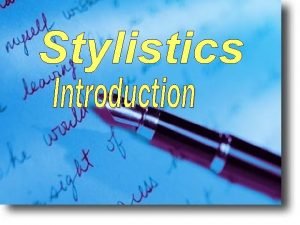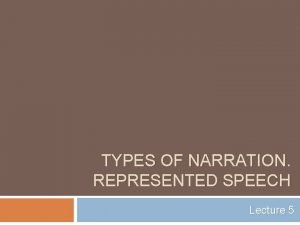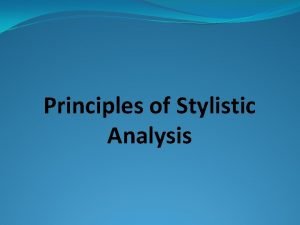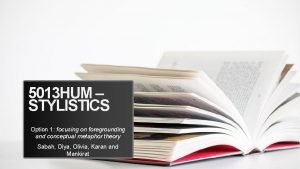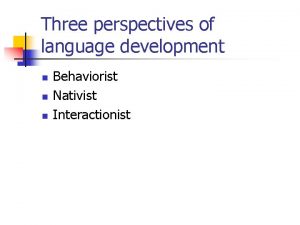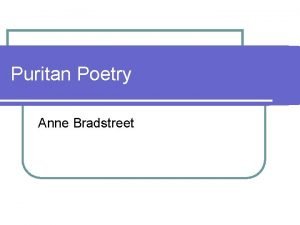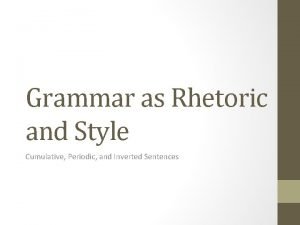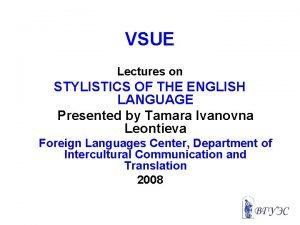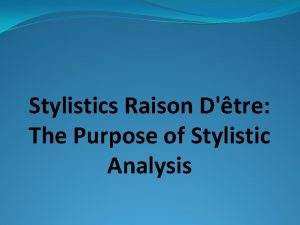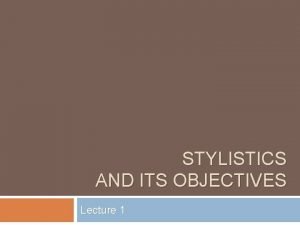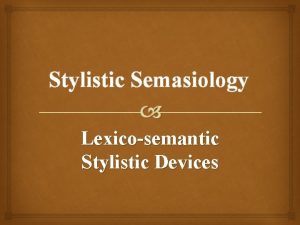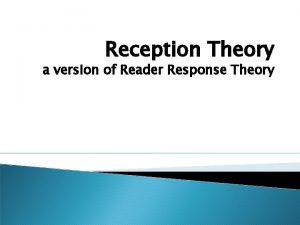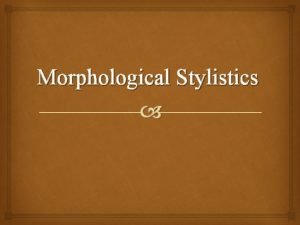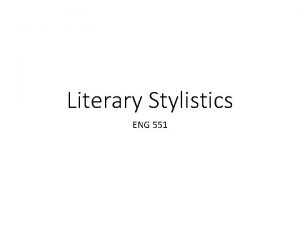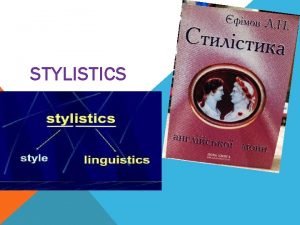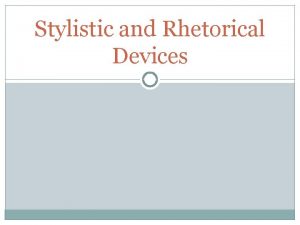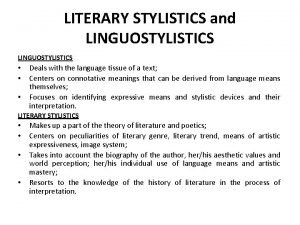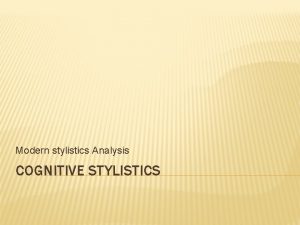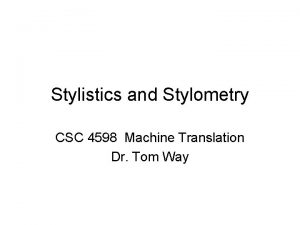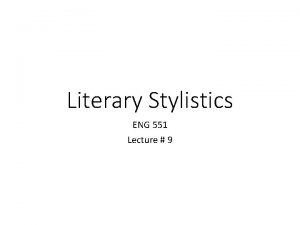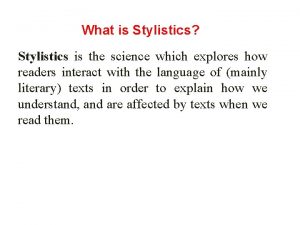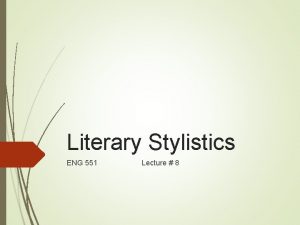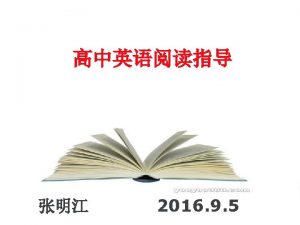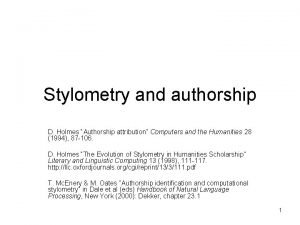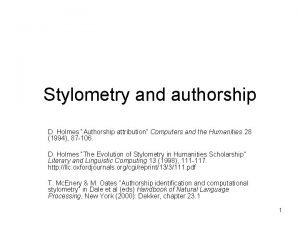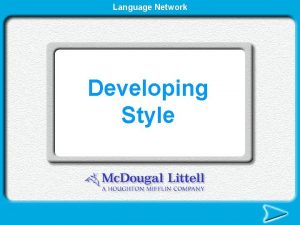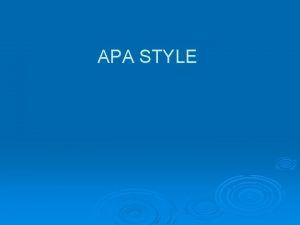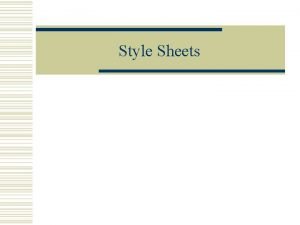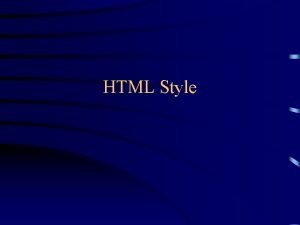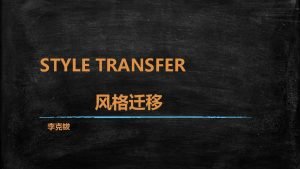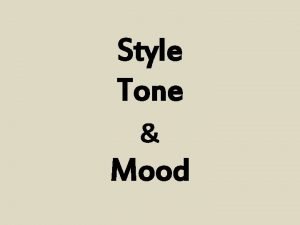Stylistics and stylometry What is style Term not




























- Slides: 28

Stylistics and stylometry

What is “style”? • Term not much loved by linguists – Too vague – Has connotations in neighbouring fields (“style” = good style, ie a value judgment) • Many books/articles make reference to etymology of the word (Lat. stilus = ‘pen’), so it follows that style is mainly about written language • Various definitions, some very close to things already seen (especially “register”) • Two main aspects widely supposed: – style is choice – style is described by reference to something else 2

Style as choice • For any intended meaning there a range of alternative ways of expressing that meaning • Different choices express nuances – of meaning – of other things (style? ) eg buy vs purchase • Example: – Visitors are respectfully informed that the coin required for the meter is 50 p; no other coin is acceptable – 50 p pieces only – Propositional meaning is the same; difference in expression conveys something else (register etc) 3

Style as choice • Style is a choice, but often the “choice” is somewhat predetermined • ie a choice between appropriate and inappropriate style • So maybe “style” is just another word for register? 4

Style and the norm • Some writers define style as – “individual characteristics of a text” – “total sum of deviations from a norm” • But what is the “norm”? – Is there some form of the language that is neutral as regards style/register? – Note also that the norm shifts: eg Bible AV was written in the vernacular of its time • Literary stylistics focuses on the exceptional 5

• Even if there is no norm, we can describe style comparatively – Stylistics mainly involves comparing and contrasting texts – and associating linguistic variance with contextual explanation • Some authors see style as being what is added to the text 6

Stylistic analysis • Gulf between literary vs linguistic stylistics – Lit crit focuses on effect on the reader, intended or otherwise, so largely intuitive and subjective – Linguistic stylistics looking for characterisations of style (including literary style) in terms of linguistic phenomena at the various levels of linguistic description 7

Stylistic analysis • Inventory of linguistic devices and their effect – usually in a contrastive way: – in contrast with other writers in a similar genre – in contrast with other genres • Linguistic devices described in terms of the usual linguistic levels of description: phonology, morphology, lexis, grammar, etc. • Effects can be directly expressive, or indirectly, by association – example: onomatopoeia vs alliteration as a phonological device 8

Stylistic analysis Crystal & Davy (1969) Investigating English Style • Informally identify stylistic features felt to be significant • Devise a method of analysis which facilitates comparison between usages • Identify the stylistic function of the features so identified 9

Types of features • “Invariable” features due to the individual or the time – usually of little interest • Discourse features – medium (= Halliday’s mode), what features distinguish written language from spoken language – participation: eg monologue vs dialogue • Province (= field) lexis and syntax • Status (= tenor) features relating to relative social standing of writer/speaker and reader/listener • Modality (= text type) eg message delivered as a letter, postcard, text message, email, etc • Singularity: deliberate occasional idiosyncracies 10

Method and function • Methods and features determine each other – you can only measure features that you can extract – simple counting features are easy to extract – more complex features can be extracted thanks to NLP techniques of corpus annotation (tagging, parsing, etc) • Describing the function of observed differences – could be based on intuition – or (see later) partially automated (factor analysis) 11

What to count • Simple things may characterise different styles – average sentence length – average word length – type: token ratio (vocabulary richness) • number of types = number of different words • number of tokens = total number of words – vocabulary growth (homogeneity of text) • number of new types in 1 st, 2 nd, …, nth 1000 words • in rich varied text, number will climb steadily • Especially when used comparatively 12

What to count • More complex analyses can give a more interesting picture – specific syntactic structures – degree of modification in NPs – types of verbs (eg verbs of persuasion, speech verbs, action verbs, descriptive verbs) – distribution of pronouns (1 st/2 nd/3 rd person) – etc … (anything you can think of) • Quite sophisticated mathematical techniques can give an overall picture – eg factor analysis: identifies from a (big) range of variables which ones best identify/characterize differences 13

Normalization and significance • Always important to compare like with like – It is usual when counting things to “normalize” over the length of the text – If one text is longer than the other, of course you would expect higher frequencies of everything • Issue of statistical significance – Small differences may not really tell you anything – Various measures can confirm whether difference is statistically significant or due to random fluctuation 14

How to count • How to recognize paragraph breaks? • How to recognize sentence breaks? – Headlines don’t end in a fullstop – Not all sentences end in a fullstop – Not all full stops are sentence ending (abbreviations) • How to count words – Hyphenated words, contractions e. g. don’t • How to measure word-length/complexity – – length only roughly corresponds to complexity number of characters vs number of syllables cf. through vs idea counting syllables implies either a dictionary or an algorithm 15

More sophisticated counting • Tagging and parsing allows you to look at grammatical and lexical issues – Use of particular POSs (conjunctions, pronouns, auxiliaries, modals) – Use of particular features (tenses, …) – Use of particular constructions (passives, interrogatives) 16

Quantifying register differences • Much work based on corpora trying to quantify and characterize register differences • Work pioneered by Douglas Biber • Simple counts like the ones suggested • Also, more complex computations 17

Example From D. Biber, S. Conrad & R. Reppen, Corpus Linguistics: Investigating Language Structure and Use, Cambriufge University Press, 1998. Ch 5: the study of discourse characteristics 18

Multidimensional analysis • Collect a huge range of measures of a wide variety – some simple word counts – syntactic features – classes and subclasses of N, V, Adj, Avd • Factor analysis 19

20

~150 features in all 21

Factor analysis • Statistical method to take large number of apparently random variables and group them together into “factors” • Factors will be groups of (+ve and –ve) features • Linguist might then try to characterize the factors in terms of some psycholinguistic feature 22

23

Example • Biber took two Google classifications of text types: “Home” and “Science” • Harvested ~1500 webpages in each category (3. 74 m words) – originally got ~2500 webpages, but some were not suitable http: //jan. ucc. nau. edu/biber/Web text types. ppt 24

25

Summary of analysis 26

27

28
 Stylometry
Stylometry Stylistics definition in linguistics
Stylistics definition in linguistics Not genuine, not true, not valid
Not genuine, not true, not valid Block format style
Block format style Types of speech style
Types of speech style Internal and external deviation in stylistics
Internal and external deviation in stylistics Defamiliarization
Defamiliarization Short, medium and long term planning in education
Short, medium and long term planning in education Example of short term human resources
Example of short term human resources Difference between long term and short term liabilities
Difference between long term and short term liabilities Difference between long term and short term liabilities
Difference between long term and short term liabilities Short, medium and long-term goals examples
Short, medium and long-term goals examples Short term financial management
Short term financial management Formal style of writing
Formal style of writing Informal writing characteristics
Informal writing characteristics Referential style vs. expressive style
Referential style vs. expressive style Puritan style poem
Puritan style poem Cumulative periodic and inverted sentences
Cumulative periodic and inverted sentences Prolepsis stylistics
Prolepsis stylistics Purpose of stylistics
Purpose of stylistics Stylistic colouring
Stylistic colouring Stylistic devices in stylistics
Stylistic devices in stylistics Psychological reader-response theory
Psychological reader-response theory Morphological stylistic devices
Morphological stylistic devices Stylistician
Stylistician Indirect onomatopoeia
Indirect onomatopoeia Basic notions of stylistics
Basic notions of stylistics Is understatement a rhetorical device
Is understatement a rhetorical device Cilimangaro
Cilimangaro

